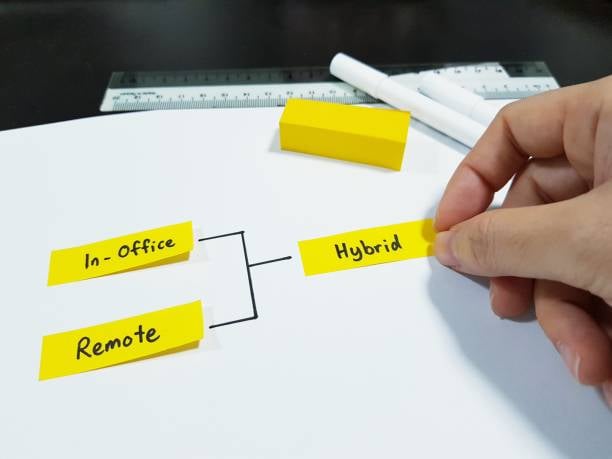

The pandemic has caused work-from-home (WFH) initiatives to skyrocket, and they show no signs of slowing down.
Not only are employees enjoying the benefits of remote work but also the productivity boost and cost savings. Despite this, many companies still see the value of maintaining an on-site team. If companies make the necessary adjustments, most employees are comfortable with returning to the workplace in some capacity.
What should your company do? Should you allow your employees to continue to work from home, bring everyone back to the office, or implement a hybrid working model? Let’s find out.
Hybrid and remote working models are often discussed in the same conversations. However, remote work is done entirely from home or somewhere other than the company office. When you deploy a remote team, your employees can work from anywhere and on a more flexible schedule. Unsurprisingly, this is ideal for many employees these days, especially younger generations.
The hybrid model is a mix of work environments. Typically, a hybrid team works long hours in the office and from home. The specific model you use depends entirely on what works best for your situation, goals, and team.
The hybrid working model isn’t new but has picked up steam recently. Since more companies offer hybrid options to their teams, much of the modern workforce wants (and expects) this type of environment to remain in place for the foreseeable future. In fact, 66% of business leaders said they're likely to transform their organizational structure to accommodate hybrid work.
When it comes to employees, many want the best of both worlds. A whopping 74% of employees want flexible remote working options, while 67% hope for more in-person interaction and collaboration post-pandemic. Point? Businesses must adapt to and implement this new working model to succeed in the long term.
Most companies currently implement five primary hybrid working models. Some companies use a combination of these models, while others use them as a platform to build their own.
Most hybrid employees fall into four categories:
An ideal hybrid work model exists for each of these personas.
Finding the right work environment for your employees is critical to a thriving business. When choosing the best model for your team, factor in the work environment, schedule, and employee roles and responsibilities.
One of the most popular employee models is the remote-first (AKA “at-will”) model. This model allows employees to prioritize remote work while continuing to work on-site via offices and coworking spaces. In a remote-first work model, your team members can stay at home or visit the office.
For example, someone who works more productively at home can decide whether to come to the office or continue working from home. If another employee thrives in an office setting, they can freely visit the workplace. Essentially, this model allows employees to use the environment that helps them work efficiently and optimizes the workforce.
By implementing the remote-first model, you're more or less showing your staff that you trust them because you're letting them choose where to work. The trust this instills in your employees can lead to higher team morale.
However, there are many challenges to the remote-first model. For example, you risk too many employees visiting the office simultaneously, jeopardizing social distancing protocols.
Also, too many unexpected visitors at once can overcrowd the office, which is especially a problem if you've downsized your physical workspace. Therefore, you must carefully manage your team using the remote-first model.
In both office-first and remote-first hybrid working models, team members can work remotely or in the office. However, in an office-first model, employees need to be more present in the physical workplace.
This model is much easier to execute and manage because you don't have to make as many digital adjustments or change protocols. Aside from tweaking some parts of your work policies (like office attendance), you can work as you normally would.
This could be the ideal working model if your company relies on collaboration for productivity. It gives teams everything they need to complete tasks and projects while offering more flexibility than a traditional model.
Additionally, the office-first model is many companies' only viable hybrid option. For example, you need on-site employees if you run a manufacturing or construction business. On the other hand, if your business relies on individual and digital output or you have remote employees, the office-first model can be counterproductive.
Scheduled and synchronized models are two schedule-based work options. These models assign your employees specific days for remote and on-site work. Using a schedule-based system works well when avoiding overcrowding your office.
For example, you can have one department at the physical workplace on Mondays, Tuesdays, and Wednesdays, while other teams come in on Thursdays and Fridays. Or you can mix and match the days in whatever works best for your team dynamics.
Many companies are experimenting with short-time work for their employees. Corporate giants like Unilever and Microsoft have claimed productivity gains by adopting a four-day workweek.
However, remember that the synced and scheduled models can increase business expenses, especially if you're paying for some of your staff’s remote working expenses. The split-week model can work well if you can afford the extra costs and a lack of team interaction.
Consider the weekly model if you're interested in a schedule-based model, but the split week isn't ideal. In this setup, you measure when specific teams need to be in the office and assign workweeks accordingly. In the other weeks, your teams can work from home.
For this model to work, choose when each team member needs to complete a full workweek in your physical office, and then other employees can switch with them by reporting to the office the following week.
If you have a large workforce, this might be the best hybrid work model for your business. This allows you to significantly reduce the office space required for operations (reducing overhead costs) and phased implementation.
There is one caveat, though: the weekly model is not flexible. Suppose you need an urgent meeting, or unprecedented problems arise in a week when the affected team is working remotely. In that case, you won't have the employees in the office exactly when you need them.
Finally, with the “designated teams” hybrid working model, you can base your facility on staff assignments – assign some teams to work full-time and others remotely. This could be the ideal structure if your business requires specific employees to be on-site at all times.
For example, you run a factory and rely on daily safety checks. You’d need specific employees on-site daily, but your sales reps or administrative staff can work from home.
Implementing this model saves money on electricity and other overheads while increasing employee efficiency. But keep in mind that the designated teams model can potentially create a gap between remote and on-site employees. Remote employees can resent their on-site colleagues building relationships with managers and learning about more opportunities.
If you're still unsure whether a hybrid working model could work well for your business, weigh the pros and cons.
Opening positions to remote employees means having access to global and local talent. You can be more selective in the hiring process to ensure you attract candidates with exceptional skills.
You may even have team members working in different time zones, which means your business will keep operating even if your physical offices are closed. Flexibility to work from home or the office maximizes your team’s productivity and engages remote employees.
One of the most apparent benefits of using a hybrid working model is the reduction in overhead. Fewer employees in the physical workplace means you can downsize to a smaller office and spend less on rent and utilities.
While it has many benefits, working remotely creates isolation and a sense of disconnect from the on-site team. Although it can be advantageous, a difference in time zones can cause management problems if your company relies on constant communication.
When working with a distributed workforce, you need to communicate more. You may primarily use messenger apps, video calls, and emails to keep in touch with your remote employees, which requires exceptional communication skills and consistent check-in on both sides.
Additionally, your on-site employees may get more opportunities for promotions or preferential treatment simply because they are in the same location as the managers.
Most changes you need to make when adopting a hybrid work model involve structuring your team to include remote employees. Here are some easy ways to create a bespoke hybrid working model.
Making the switch to hybrid work is always easier with employee feedback. Running a simple employee survey can help you determine which of the four hybrid work personalities matches each team member.
Using the survey results and steps outlined below, you can work toward successfully implementing a hybrid work model in your company.
You need to transition to an asynchronous communication style, meaning you don't expect your team members to respond immediately upon contact. To pull this off, you must provide each remote employee with all the information needed to complete a task in their own time.
You also need to change how you conduct meetings. If you use the asynchronous communication method, you don't have to hold daily meetings to touch base with your co-workers and present project updates. All you have to do is connect everyone to one project management app, saving everyone time.
Hackers constantly look for ways into corporate systems and networks. Inadequate security measures can wreak havoc on your systems. As you inevitably use more technology when implementing a hybrid working model, you must plan to invest more in cybersecurity and tech support.
Make sure each of your employees follows your company's security protocols, whether they're working in the office or remotely.
Use project management and collaboration tools to keep your operations running efficiently and use them to build a culture and community among your workforce. This is essential for remote employees who cannot interact in person. By reducing feelings of isolation and helping them feel more included, you can boost morale while reducing turnover.
While you're at it, schedule wellness breaks for everyone on your team. Remote employees are particularly prone to burnout, and by giving them quiet days and opportunities for informative seminars, you can help your team stay healthy, happy, and productive.
If your company is exploring the possibility of a remote workforce but still needs on-site support, a hybrid working model could be the ideal option. Consider the different models above and evaluate your needs to determine which one works best.
Remember to consider all the steps you can take to keep your on-site and remote employees happy, engaged, and productive. With the right approach, you can position your business to save money, increase sales, and attract top talent worldwide.
Rewarding your employees is a great way to make them feel included. Find out how employee rewards boost employee morale.

Create engaging events and deliver the feel and value of in-person events with virtual event platforms.
Dan Bladen is co-founder and CEO of Kadence. Dan founded Kadence 8 years ago, which was revived during the pandemic. He shot a non-profitable hardware co. into a SaaS co. to having more than 130 B2B customers.

Create engaging events and deliver the feel and value of in-person events with virtual event platforms.
Hybrid models are the future of the workplace.
 by Annabel Benjamin
by Annabel Benjamin
The workplace of today looks very different from that of a few years ago. The option for...
 by Max Chopovsky
by Max Chopovsky
The world has gone hybrid.
 by Dayana Mayfield
by Dayana Mayfield
Hybrid models are the future of the workplace.
 by Annabel Benjamin
by Annabel Benjamin
The workplace of today looks very different from that of a few years ago. The option for...
 by Max Chopovsky
by Max Chopovsky
Never miss a post.
Subscribe to keep your fingers on the tech pulse.



